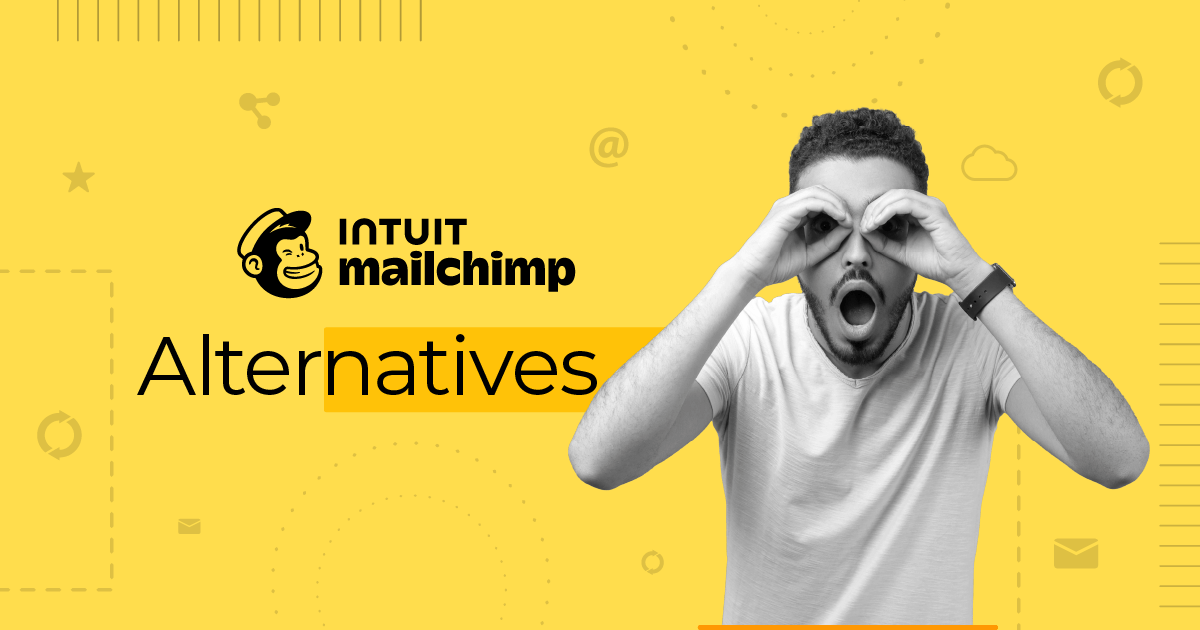
8 Web Push Notification Tools You Have to Check in 2025
Suppose you want a direct, permission-based way to re-engage people after they leave your site. In that case, web push notification tools can deliver timely messages on both desktop and mobile, without relying on email or phone numbers.
In this blog post, we’ll quickly explain what web push notifications are and why they work, share a comparison table of the top tools, and then break down each option with clear pros, cons, and best-for scenarios.
By the end, you’ll know exactly which web push solution fits your goals and budget.
What is a Web Push Notification?
A web push notification is a short, clickable message that a website sends through a user’s browser after they give permission. It can appear on desktop or mobile, even when the visitor isn’t on your site, making it a simple way to bring people back at the right moment.
Unlike email or SMS, web push doesn’t require personal data since the browser handles consent.
Notifications typically include a title, a brief message, an icon, and a link to a specific page.
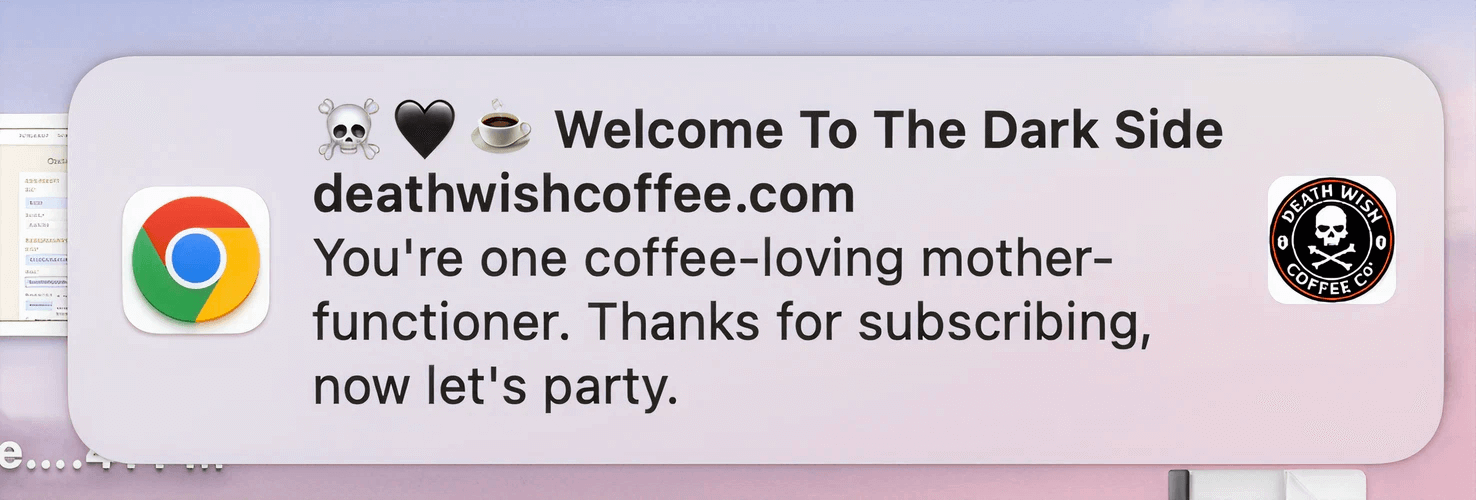
Brands typically use them for:
- new content
- price drops
- abandoned cart reminders
- product launches
- time-sensitive alerts
- flash sales
Good tools let you segment audiences, schedule or trigger messages based on behavior, and measure performance (deliveries, clicks, conversions).
Why Should You Use a Web Notification Tool?
As we mentioned before, a web push notification tool can help you engage visitors even after they leave your website by delivering targeted and personalized messages.
While many businesses underestimate this tactic, here are some serious benefits that these tools offer.
- Instant reach and high visibility: Deliver timely, clickable messages on desktop and mobile.
- Easier opt-in: No email or phone is needed. Consent is browser-based, improving signup rates and reducing data risk.
- Precise targeting: Segment by behavior, page views, geography, device, or custom events to send relevant messages only.
- Personalized messaging: Insert dynamic content (name, product, price, inventory) and direct users to tailored URLs.
- Automation: Using pre-built automation sequences, you can increase your revenue without manual sends.
- Cross-browser support: Target multiple audiences across Chrome, Firefox, Edge, and Safari on iOS/iPadOS
- ROI optimization: Push notification tools track deliveries, CTR, conversions, and revenue to help you identify what works.
Top Web Push Notification Software: Compared
Now, let’s look at a quick comparison table of the best solutions.
| Free Plan/Trial | Pricing | Supports | |
| PushEngage | Yes | $19/month | Web, mobile and RSS notifications |
| Webpushr | Yes | $29/month | Web push notifications |
| OneSignal | Yes | $19/month (+ usage costs by channel) | Web and mobile push notifications |
| Wisepops | 14-day trial | $49/month | Web push notifications |
| Pushwoosh | Yes | $12/month | Web and mobile push notifications |
| PushAssist | Yes | $9/month | Web push notifications |
| iZooto | Yes | $85/month | Web push notifications |
| PushOwl | Yes | $19/month | Web push notifications |
1. PushEngage

Pricing: Paid plans start at $19/month, free plan
Supports: Web, mobile, and RSS notifications
Best for: Ecommerce and content sites needing powerful automation and segmentation
PushEngage is among the best web push notification tools available, ideal for both beginners and advanced users. It’s easy to set up push notifications for new blog posts, product announcements, and abandoned carts. You can also deliver automatically triggered notifications based on your visitors’ behavior.
With its dynamic segmentation, you can use specific push notifications to target the right subscribers and maximize your results. There is also an AI assistant that helps write content for the notifications.
The platform’s user interface is also user-friendly, while the campaign editor is very straightforward. Another handy feature is A/B testing, which lets you experiment with any element to optimize your notifications. Regarding PushEngage’s reporting capabilities, the tool lets you set revenue goals for your campaigns and track the growing transactional value in real-time.
On the integration side, you can connect PushEngage with WordPress/WooCommerce and Shopify for plug-and-play operation. You’ll find a library of advanced e-commerce triggers and built-in drip campaigns that make “set it and forget it” automations realistic for small teams. Overall, this is a tool that caters to the needs of all types of businesses.
Pros
- Works on all devices: desktops, tablets, and smartphones (iOS and Android)
- Built-in A/B testing and clear reporting help you optimize quickly
- Affordable pricing
Cons
- A credit card is required to try the free plan
- You need a paid plan for advanced features
Pricing
PushEngage has a limited free plan that lets you send 30 mobile and browser push campaigns per month and build a list of 200 subscribers. Paid plans start at $19/month, unlocking more features and better customer support.
2. Webpushr
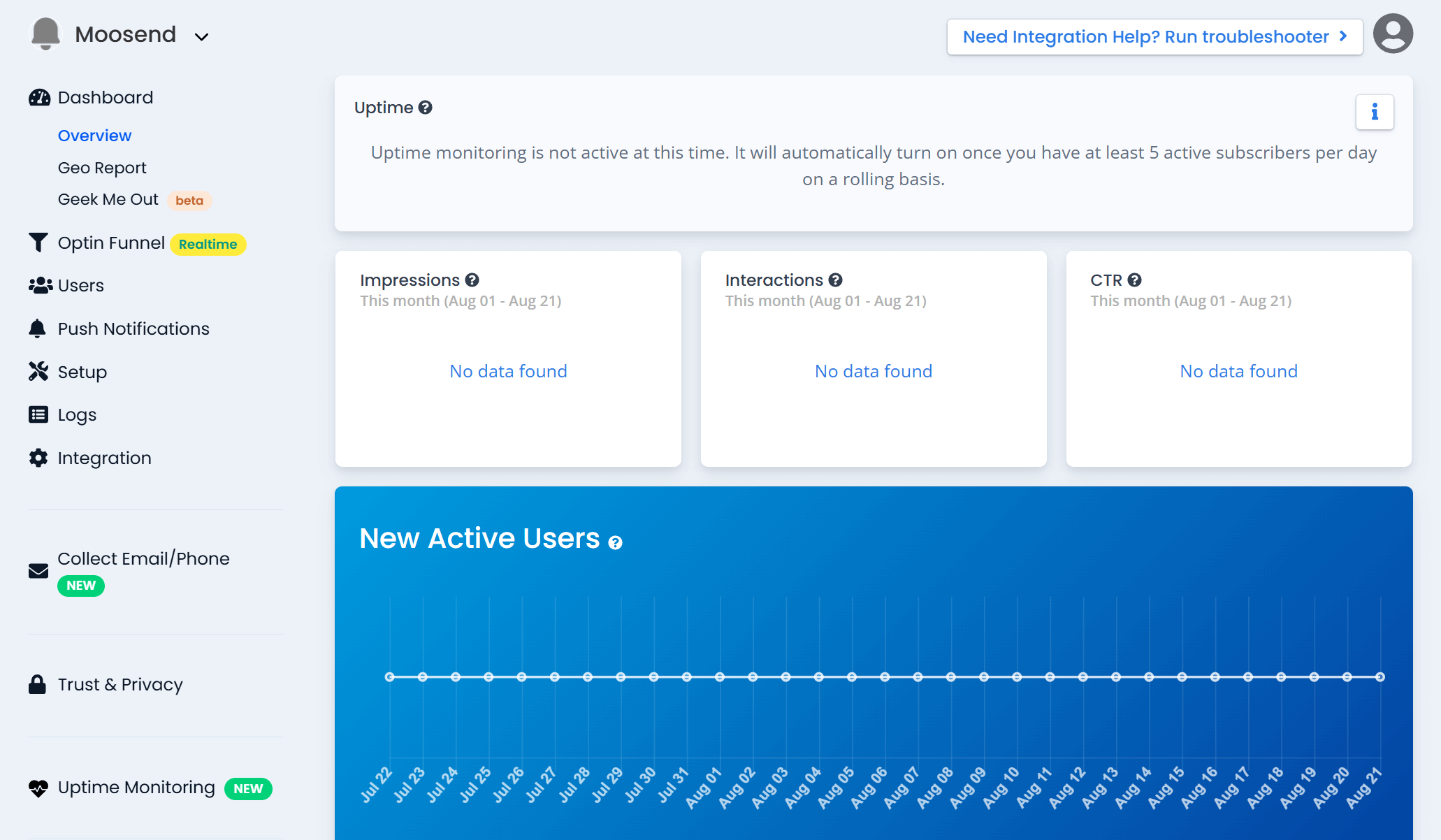
Pricing: Paid plans start at $29/month, free plan
Supports: Web push notifications for desktop and mobile browsers
Best for: Businesses looking for generous free limits
Webpushr is a free web push notification tool that supports all popular browsers. Its free plan offers unlimited notifications and access to all the features, limiting you only on the number of subscribers (who can receive push notifications). This makes the tool an attractive choice for growing businesses that don’t want early restrictions. You can use it to send personalized messages with custom attributes, schedule notifications, or set up automated triggers such as welcome flows or content updates.
It also comes with segmentation and targeting tools, allowing you to deliver the right messages to specific user groups based on their activity, location, or device. Webpushr integrates seamlessly with WordPress, Shopify, and Zapier, giving you flexibility to connect with your existing stack. Other notable features include multi-user support and HTTPS-free setup.
All in all, with its minimal learning curve and rich features, this tool can be a great asset in your marketing arsenal.
Pros
- All features are available even in the free plan
- Seamless integration with WordPress and WooCommerce
- Team collaboration features
Cons
- Lacks built-in A/B testing
- Limited advanced automation compared to other competitors
Pricing
This web push notification tool offers a great free plan that includes all the platform’s features. The only limit is on the number of subscribers you can have (up to 10K). Paid pricing starts at $29/month for up to 50K subscribers.
3. OneSignal
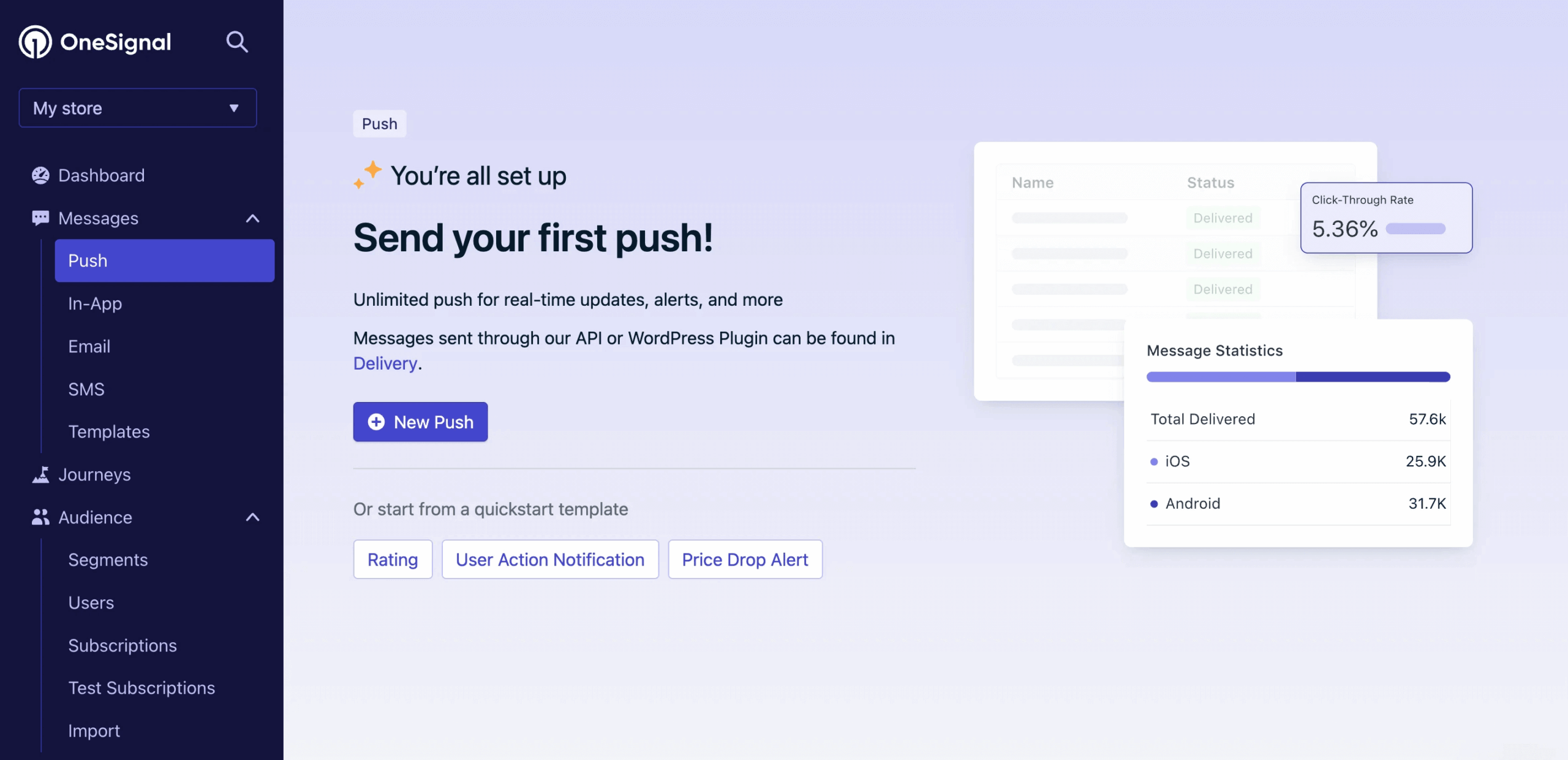
Pricing: Paid plans start at $19/month, free plan
Supports: Web and mobile push notifications
Best for: All-in-one messaging with cross-channel reach
OneSignal is one of the most popular push notification platforms, trusted by startups and enterprises alike. You can use it to send web push, mobile push, email, and SMS from a single dashboard, making it a versatile choice for centralized messaging. Its visual editor and prebuilt templates make campaign creation straightforward, while the real-time segmentation lets you target users based on actions, location, or custom events.
Apart from that, you can set up automated workflows such as onboarding sequences, re-engagement campaigns, or abandoned cart recovery series. You can also conduct A/B tests to improve performance. OneSignal integrates with popular platforms like WordPress, Shopify, HubSpot, and Segment, fitting into your existing marketing stack easily.
Overall, OneSignal stands out for its multi-channel capabilities, ease of use, and scalable infrastructure that can handle everything from a small blog to enterprise-level messaging.
Pros
- Supports multiple channels beyond push (email, SMS, in-app)
- Wide range of integrations with popular platforms
- Great in-app messaging
Cons
- It gets expensive the more your business grows
- Some users have reported issues with the customer support
Pricing
OneSignal offers a free plan with unlimited mobile and web push notifications for up to 10,000 subscribers. Paid plans start at $19/month (plus usage costs by channel), adding intelligent delivery, advanced in-app messaging, and more integrations.
4. Wisepops
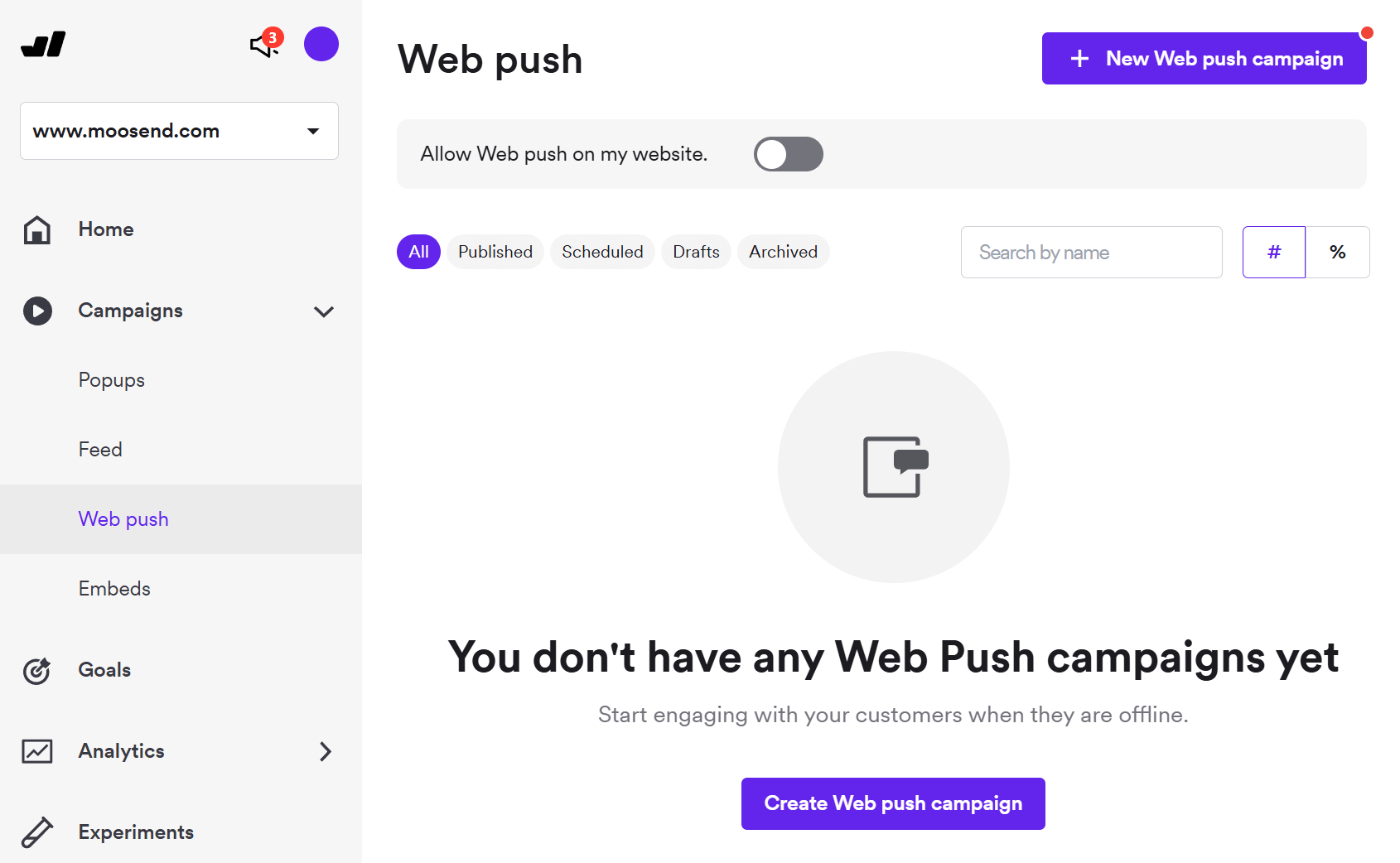
Pricing: Paid plans start at $49/month, 14-day free trial
Supports: Web push notifications
Best for: Mid-sized and large ecommerce businesses
Wisepops is an on-site engagement platform that lets you capture and engage your audience with pop-ups, product recommendations, and web push notifications. You can use it to build popups, banners, surveys, and notification campaigns in one intuitive drag-and-drop editor. The push notifications integrate seamlessly with these other formats, letting you capture visitors onsite and re-engage them later through browser push.
Regarding segmentation, you can group subscribers based on behavior, source, or UTM parameters, and then schedule or trigger notifications to bring them back. With Wisepops, you can also personalize campaigns using dynamic content and deliver real-time offers like discounts, countdowns, or product announcements.
What makes this a good web notification tool is its ability to connect onsite engagement with offsite re-engagement. You capture visitors while they’re browsing and then bring them back later with targeted push notifications. Finally, the tool is equipped with detailed engagement analytics to understand the impact of your campaigns.
Pros
- Easy drag-and-drop editor with strong design flexibility
- It combines push notifications with popups, banners, and onsite campaigns
Cons
- No free plan
- It has a learning curve
- Entry pricing is higher than that of some competitors
Pricing
Wisepops has a 14-day free trial that allows you to test all its features. Pricing starts at $49/month and increases based on your website’s monthly pageviews.
5. Pushwoosh
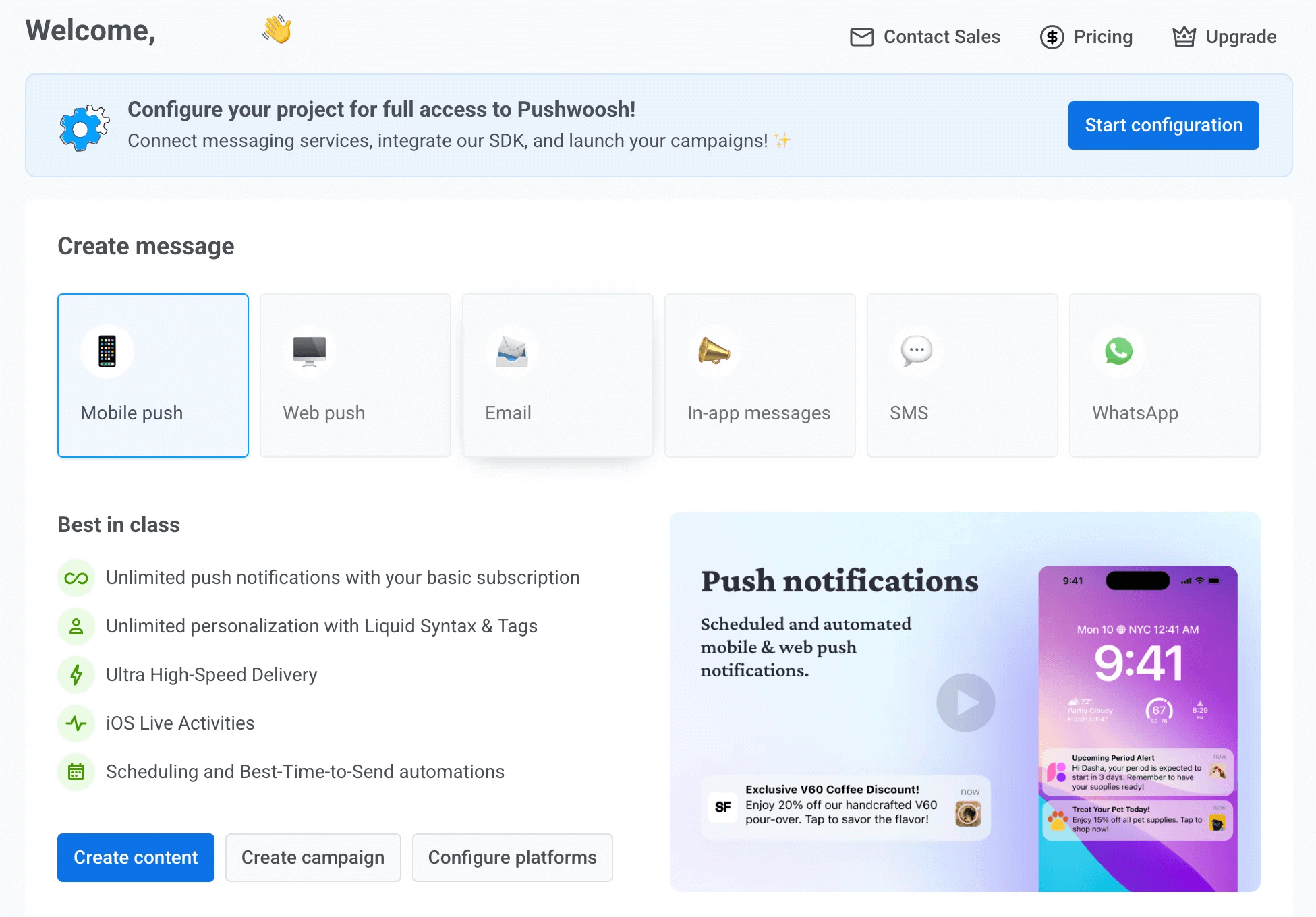
Pricing: Paid plans start at $12/month, free plan
Supports: Web and mobile push notifications
Best for: Cross-platform push notifications with strong analytics
Pushwoosh is a versatile solution that incorporates web push, mobile push, in-app messaging, and email. You can use it to send targeted campaigns across multiple devices and platforms, making it especially useful for businesses with both web and mobile audiences.
The tool lets you deliver precise and relevant messages via its advanced segmentation (based on behavior, demographics, and custom events). You can also set up automated workflows such as onboarding series, retention campaigns, or promotional pushes, and monitor performance in real time. It also offers multi-language support, making it a strong option for businesses with global audiences.
Pushwoosh has affordable entry-level pricing, which is great for startups and growing businesses. The interface is modern and straightforward, letting you navigate its extensive functionality with ease.
Pros
- Multi-language support for global campaigns
- Strong analytics and real-time tracking
- Unlimited push notifications on all paid plans
Cons
- It has a learning curve due to its extensive features
Pricing
Pushwoosh has a limited free plan that provides access to the entire platform until your app reaches 1,000 push subscribers. Paid plans start at $12/month for 5,000 subscribers and unlimited web and mobile push notifications.
6. PushAssist
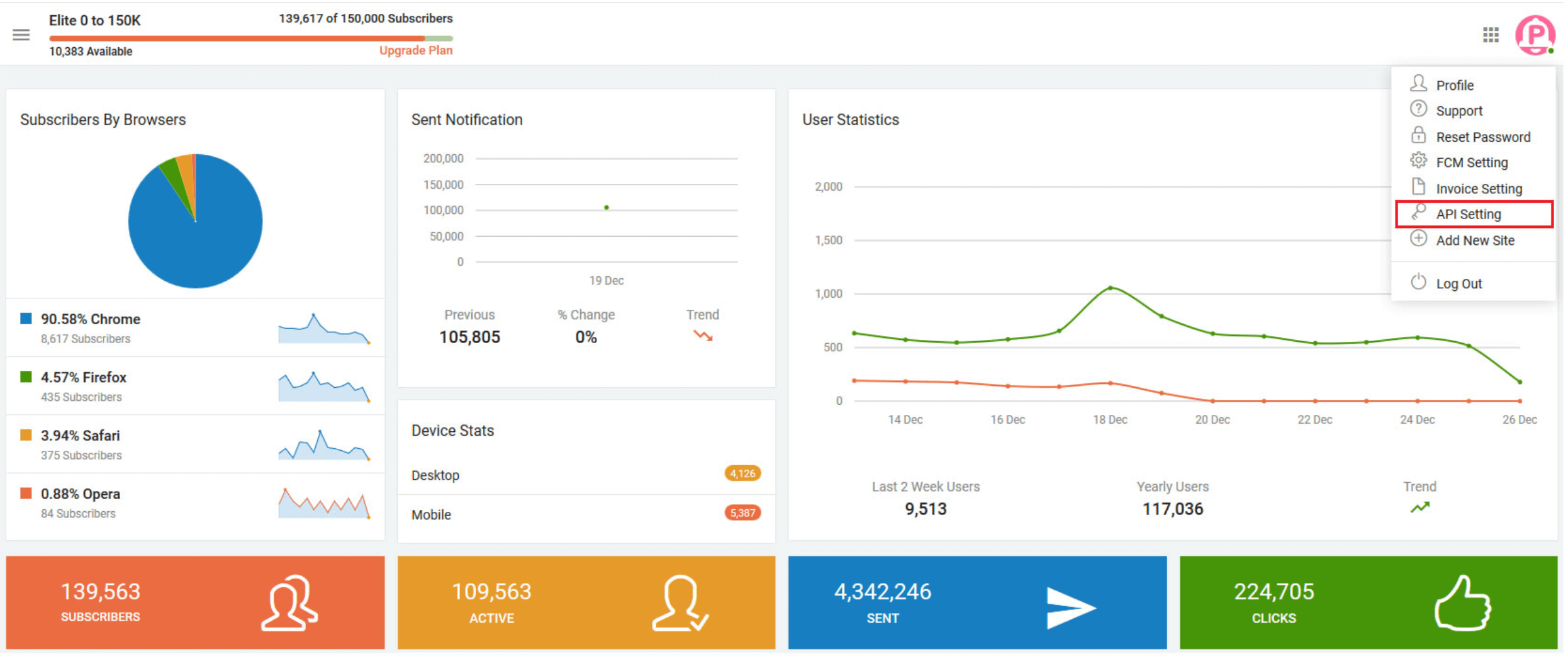
Pricing: Paid plans start at $9/month, free plan
Supports: Web push notifications
Best for: Small to mid-sized businesses looking for a simple push solution
PushAssist is a straightforward web push notification platform that balances ease of use with essential marketing features. It works across major browsers, including Chrome, Firefox, Safari, and Edge, making it accessible to a broad audience without advanced technical setup.
With PushAssist, you can send personalized notifications based on user attributes like location, device, or browsing behavior. It also supports scheduled campaigns for time-sensitive promotions and automated triggers such as welcome messages, abandoned cart reminders, or content updates. For developers, PushAssist offers a REST API so you can integrate notifications into custom workflows or apps.
Overall, PushAssist is a flexible solution. This means that marketers can easily run campaigns through a simple dashboard, while developers can use the API to build more advanced, custom workflows.
Pros
- REST API for custom integration and automation
- Supports both manual campaigns and automated triggers
Cons
- Interface feels basic compared to other tools
- Advanced analytics and segmentation are only available in higher tiers
Pricing
PushAssist offers a free plan for up to 3,000 subscribers and 120 notifications per month. Paid plans start at $9/month, scaling with subscriber count and unlocking advanced features such as segmentation, HTTPS support, and detailed reporting.
7. iZooto

Pricing: Paid plans start at $85/month, free plan
Supports: Web push notifications
Best for: Publishers and media companies
iZooto is another web push notification tool built with publishers and media brands in mind. Instead of focusing on ecommerce triggers, it emphasizes audience engagement and retention. You can use it to send breaking news alerts, content recommendations, or personalized updates that drive readers back to your site multiple times a day. It also supports A/B testing and timezone-based notifications.
iZooto’s standout feature is its audience monetization capability, which lets publishers run push notification ad campaigns to generate additional revenue. Its segmentation and personalization tools ensure that the right readers receive the right content, improving CTRs and repeat visits. The platform also supports multi-language notifications, making it suitable for global news outlets.
All in all, iZooto is less about product sales and more about keeping readers engaged, loyal, and profitable.
Pros
- Multi-language support
- Supports audience monetization with push ads
Cons
- Pricing starts higher than most alternatives
- Small number of templates for push notifications
Pricing
This push notification tool has a free forever plan with 10 campaigns per day and access to push notification APIs. Paid plans then start at $85/month.
8. PushOwl
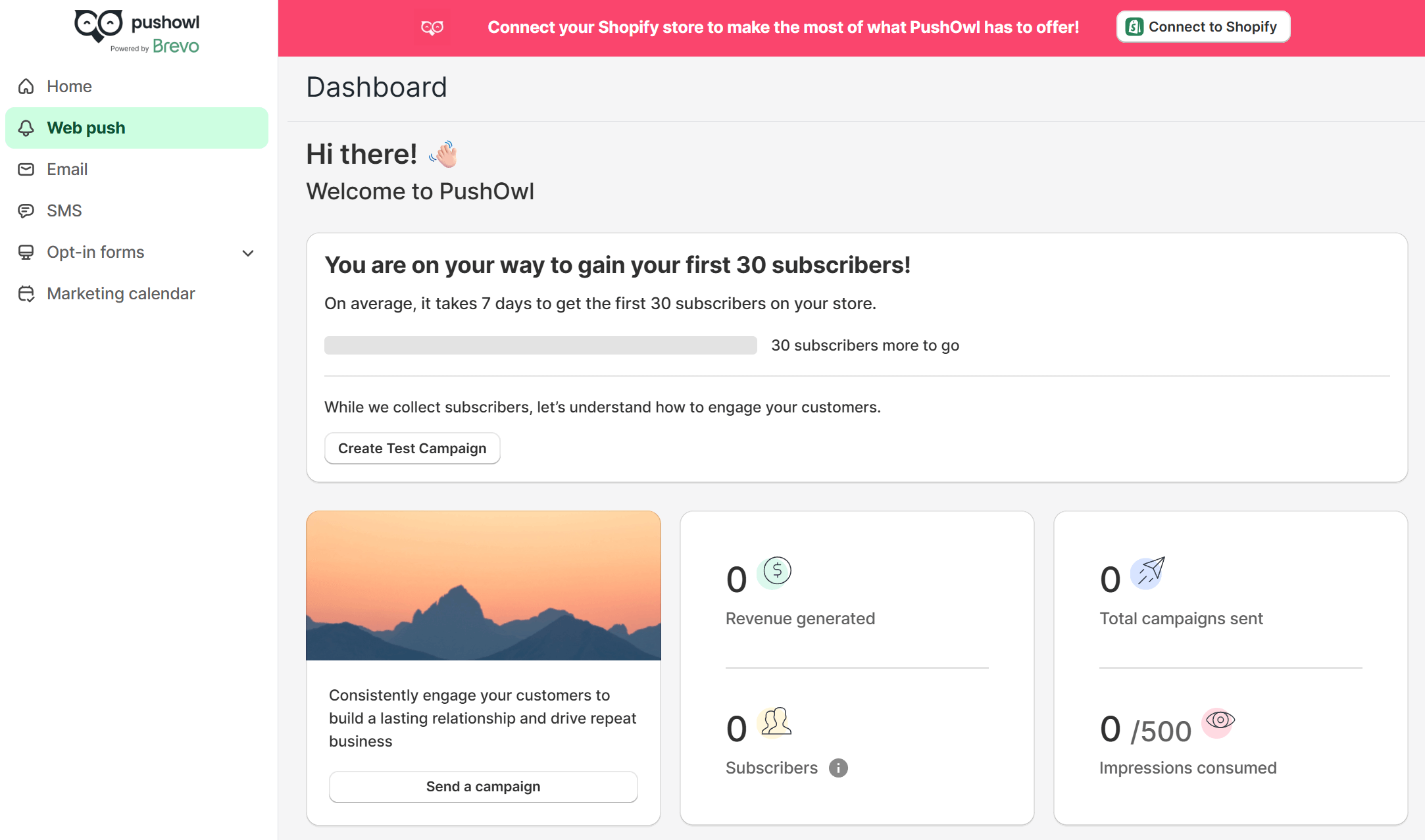
Pricing: Paid plans start at $19/month, free plan
Supports: Web push notifications
Best for: Shopify stores
PushOwl is designed specifically for Shopify stores, making it one of the easiest web push solutions to set up if you’re already using Shopify. You can recover abandoned carts, send back-in-stock alerts, announce flash sales, or share discount codes directly with subscribers.
The platform is known for its seamless integration. Once installed from the Shopify App Store, it automatically syncs with your store data so you can start sending campaigns without coding. PushOwl also offers automation features like drip campaigns and customizable opt-in prompts to help grow your subscriber base.
If you’re looking for a tool built around ecommerce use cases, PushOwl will be a great fit, requiring minimal technical effort to start generating ROI.
Pros
- Tailored for Shopify with simple setup and native integration
- Strong ecommerce automations (cart recovery, back-in-stock, flash sales)
Cons
- Not suitable for non-Shopify stores
- Advanced features like segmentation and analytics require higher-tier plans
Pricing
PushOwl offers a free plan with basic features to get started. Paid plans start at $19/month and scale with subscriber count, unlocking advanced automations, segmentation, and detailed reporting.
Selecting the Right Web Push Notification Tool
With so many web push notification platforms available, the right choice depends on your business goals and setup. Ultimately, the best tool is the one that aligns with your audience, integrates smoothly with your stack, and provides the features you’ll actually use.
Take advantage of free trials and starter plans to test usability, reporting, and ROI before committing. By matching your needs to the right platform, you’ll turn push notifications into a reliable driver of engagement, retention, and revenue.
Frequently Asked Questions (FAQs)
Here are some frequently asked questions regarding web push notifications.
1. How do web push notifications work?
Web push notifications are short messages sent through a user’s browser. When someone visits your website, they may see a prompt asking if they want to allow notifications. If they click “Allow,” the browser saves their permission so you can send them updates later directly to their computer or phone, even when they’re not on your site. Each notification can include a title, text, image, and link. It’s a simple, safe way to reach visitors without needing their email or phone number.
2. What to consider when choosing a web notification tool?
When choosing a tool, think about your main goals, whether it’s recovering carts, sending news updates, or boosting return visits. Key features to look for include automation, segmentation, personalization, and clear reporting. Check which browsers and devices are supported, and whether the tool integrates easily with your website platform (like Shopify or WordPress). Pricing and scalability also matter, especially as your subscriber list grows. Finally, ensure the tool is user-friendly and complies with privacy laws like GDPR.
3. What’s the difference between web and mobile push?
Web push notifications are sent through internet browsers on desktop or mobile, while mobile push notifications require an application to be installed on a phone or tablet (e.g., the CNN app). For example, a news website might send a web push through your browser saying “Breaking: Major storm approaching,” while the CNN app could send a mobile push directly to your phone’s lock screen.




